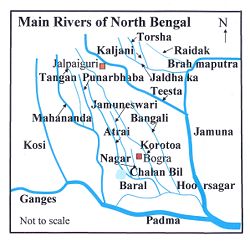| Torsa River Machu, Amo Chhu | |
|---|---|
 Torsa River near Cooch Behar | |
 | |
| Location | |
| Country | China, Bhutan, India, Bangladesh |
| Cities | Phuntsholing, Jaigaon, Hasimara, Cooch Behar |
| Physical characteristics | |
| Mouth | Brahmaputra River |
| Length | 358 km (222 mi) |
| Basin features | |
| Tributaries | |
| • left | Kaljani |
The Torsa River (also spelt Torsha and also known as Kambu Maqu, Machu and Amo Chhu) rises from the Chumbi Valley in Tibet, China, where it is known as Machu. Its course continues into Bhutan, India, and Bangladesh before joining the Brahmaputra River into the Bay of Bengal.